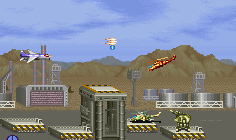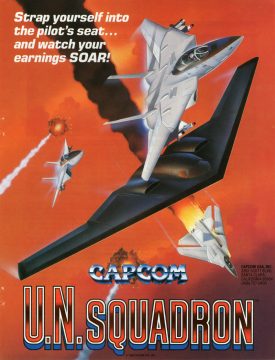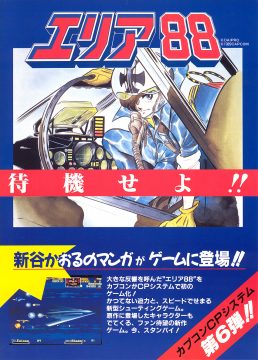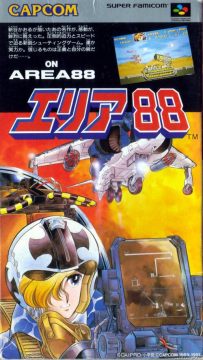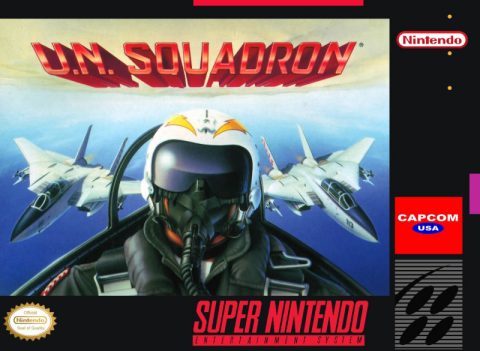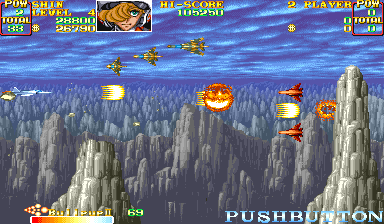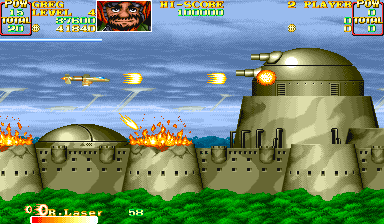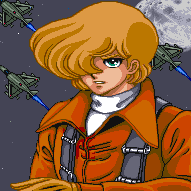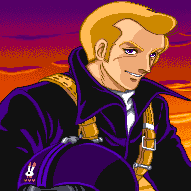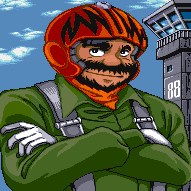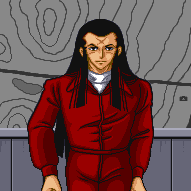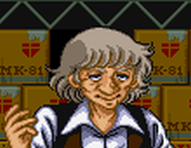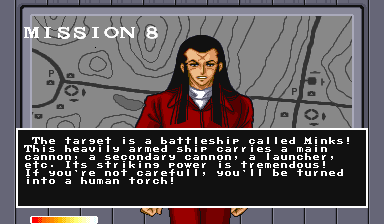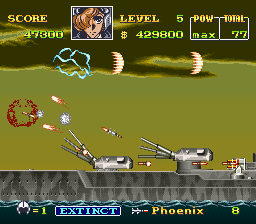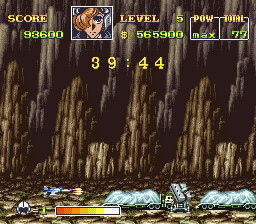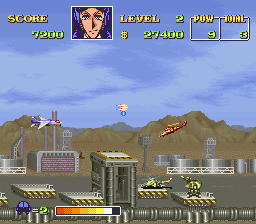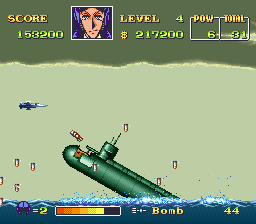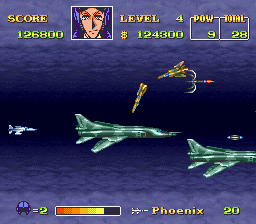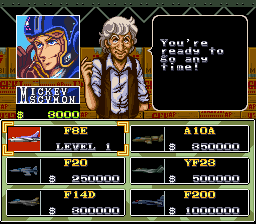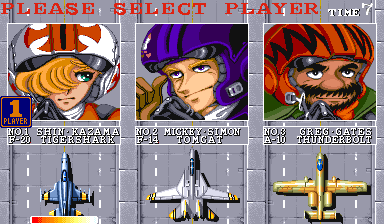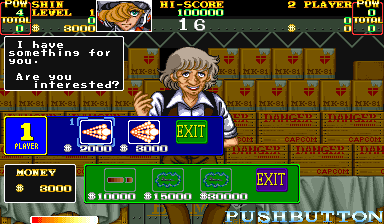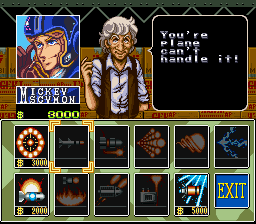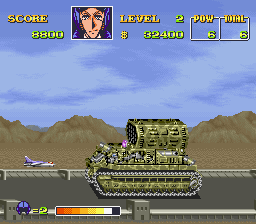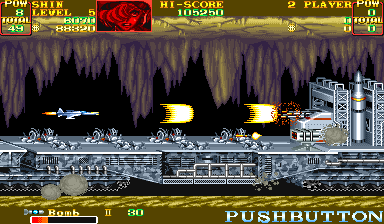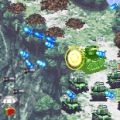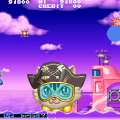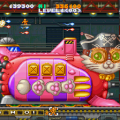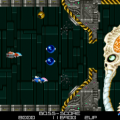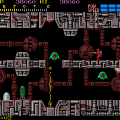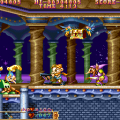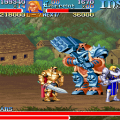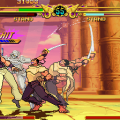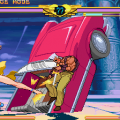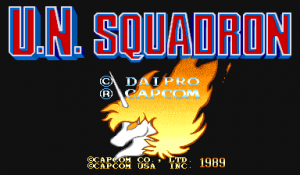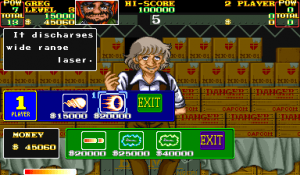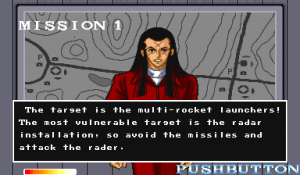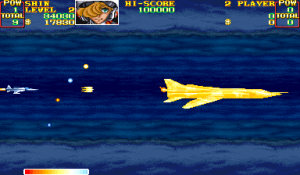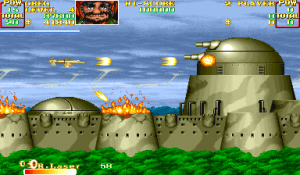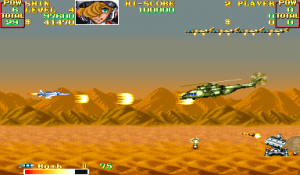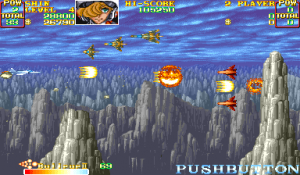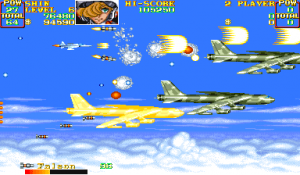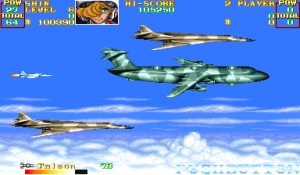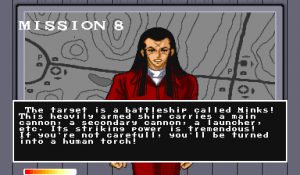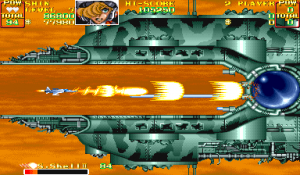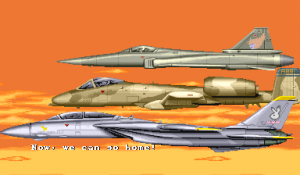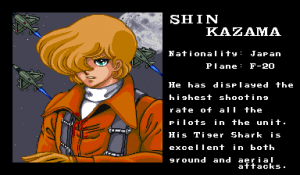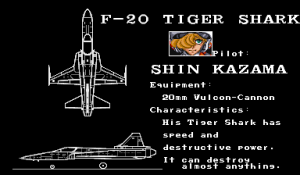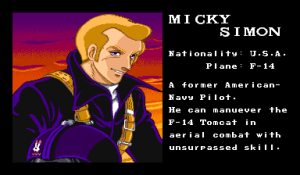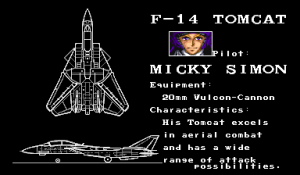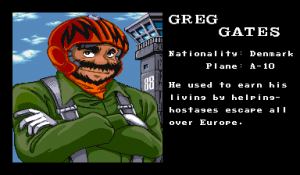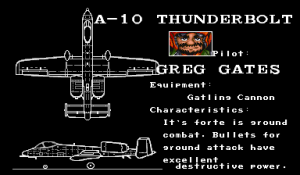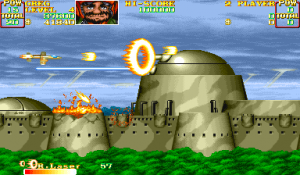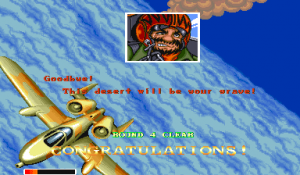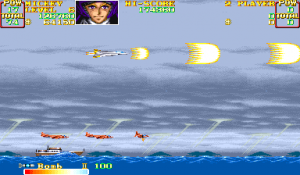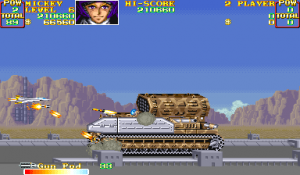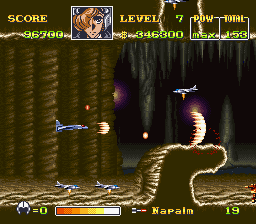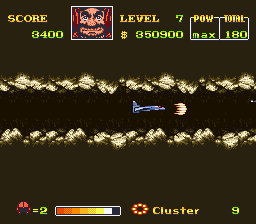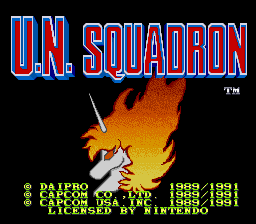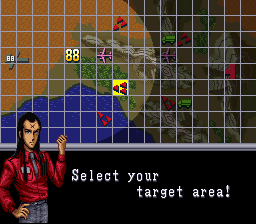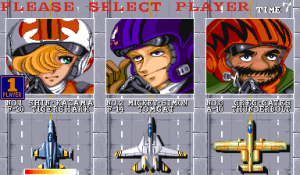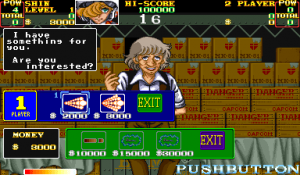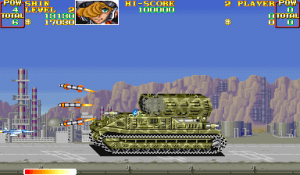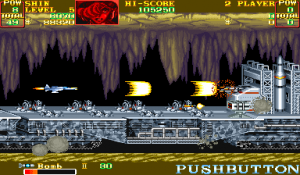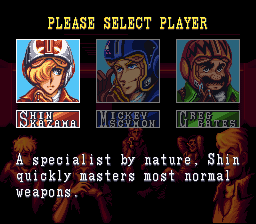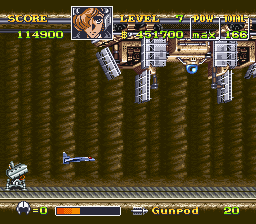- U. N. Squadron
When one thinks of media depicting the tragedy of war and the toll it takes on the minds and bodies of those who serve or have served, one might think of Tomino’s various Gundam series. However there is another series from Japan that does not hold back when it comes to dealing with these issues and themes. In the west however many have not realized they’ve touched upon this series in the form of a side-scrolling shooter named U.N. Squadron, more properly known as Area 88.
First published in 1979, Area 88 (written by mangaka Kaoru Shitani) is the story of a man named Shin Kazama. Shin is an up and coming piloting genius who seems to have a great future ahead of him. He’s top of his class, is recognized by a respectable airline and is courting the daughter of the president of said airline. It all comes crashing down one night mere days before completing his courses when he is tricked by a man who he thought was a friend. Utilizing copious amounts of alcohol he tricks Shin into signing a form enlisting him in a foreign legion. Shin must either serve a 3 year term, or pay a 1.5 million US Dollar penalty fee to buy out his contract. Due to his piloting skills, he is made to learn to become a fighter pilot at the hidden military base Area 88. He quickly proves to be very skilled at killing, something which he loathes.
The manga of Area 88 has been well-regarded for its accurate depiction of various jet aircraft by aviation enthusiasts as well as its strength of character writing and storytelling. It was one of the first three manga to be translated and released stateside, (the other two being Mai, the Psychic Girl and Legend of Kamui) had three OVAs based on it made in 1985 and re-released in 2006 on DVD with English localization. Naturally when video games came to reach a certain degree of sophistication, an adaptation of Shitani’s classic tale of tragedy was all but certain.
Area 88 was initially released in the Arcades of Japan in August of 1989. North America and Europe received more localized versions of the game as U.N. Squadron the same year. Developed and published by Capcom, Area 88 is a bit of a departure from the development giant’s usual arcade shooter fare. Contrary to the quite successful 194X series, Area 88 is instead a horizontal shooter as opposed to Capcom’s usual vertical shooters. Similar to its successful predecessors however, Area 88 features an energy bar allowing the player to take multiple hits before dying, something that remained rather uncommon in the arcade scrolling shooter scene.
At the outset of the game, the player or players are instructed to pick one of three pilots from the series: main character Shin Kazama in his F-20 Tigershark, friend of Shin’s Mickey Simon in his F-14 Tomcat and comedy relief fan-favorite Greg Gates piloting an A-10A Thunderbolt II. Each pilot has their own characteristics to give them a unique mechanical advantage in addition to cosmetic distinction. This choice is an important one as even upon death and continuing as the expense of a credit, the pilot decision is locked in and cannot be changed until a new game session has begun.
Characters
Shin Kazama
A Japanese piloting genius tricked into working off a mercenary contract. He has a medium strength vulcan cannon and has no poor auxiliary weapon choices. In the SNES version his vulcan cannon requires fewer POW-ups to level.
Mickey Simon
A former U.S. Navy pilot from New York who couldn’t adjust back to civilian life. He has a strong vulcan cannon and Air-to-Air options, but weak Air-to-Ground options. In the SNES version he gets more milage out of auxiliary weapons.
Greg Gates
A pilot from Denmark that helped hostages escape with the reputation of being unkillable. He has a gatling gun that is lacking in forward strength in exchange for having a second gun that fires at a downward angle as well as having strong ground options but lacking air options. In the SNES version he recovers from danger mode the quickest.
Saki Vashtal
Lt. Colonel in charge of Area 88. In the source material he is a prince of the Aslan government resisting the anti-government forces. Here he just hands out mission briefings.
McCoy
A crooked dealer if there ever was, McCoy is the quartermaster of Area 88. He has a reputation for selling scavenged parts and weapons of dubious quality.
Further setting itself for distinction, Area 88 maintains the theme of the mercenary nature of it’s source material. Before each mission, the player is briefed by Lt. Colonel Saki Vashtal for the situation in the upcoming level with a backdrop borrowed from the OVAs. Afterwards the option to purchase secondary weapons and defensive upgrades from shady quartermaster McCoy arises. McCoy will offer a weak and a strong class of auxiliary weapon. The weapons being offered are tied to the given level. In addition, the option of an expanded energy bar as well as a shield, in three and five-hit varieties, are always available. The player’s money is, however, limited and is determined by how many enemies are downed in each level. While not much to manage, sometimes the question comes down to extra firepower or more sustainability for the mission at hand.
One thing the player will quickly realize is that when firing the plane’s basic gun, if held it will let out around 10 shots and then stop until pressed again. Thus, the player’s basic attack can be considered a long-burst weapon, rather than single-shot or full-auto like most other shooters. Certain enemies and enemy formations are different colors than other enemies of the same type. Destroying them will yield a red or blue POW-up. On their own, they do nothing. However if the player collects enough of the POW-ups with the reds being worth 1 and the blues worth 2, the plane’s gun will level up becoming stronger and wider with an improved capacity to continue after hitting a weaker target. POW-ups are not the only pick-up available to the player, as Area 88 has the usual smattering of healing and score items with Capcom’s iconic Yashichi fully restoring the energy bar, in addition to money and auxiliary ammo restoratives. If the player sprung for one of McCoy’s auxiliary weapons, their name and ammunition count will be displayed in the bottom left over the energy bar. Each has their own characteristics and useful for different situations. While McCoy is crooked, he’s also sharp. The limitation of one weapon class per level isn’t really a hindrance, as the weapons he provides tend to cover the fighter’s weaknesses in the level quite effectively such as bombs and napalm when there are many ground targets and homing missiles when air-to-air is the order of the day.
Visually, Area 88 offers crisp visuals at its native 384 x 224 raster display with care and detail applied to everything from the pilot’s customized jets to the various enemies and locale. Enemy planes will fly in formation and perform aerobatic maneuvers such as coming about or rolling successively. In addition there are several incidental effects such as fires and atmospheric conditions at given set pieces. The audio is the game’s weakest offering with many harsh sound effects that, while more or less appropriate, suffer from the limitations of audio design at the time. This is rather unfortunate as Area 88 has an original score by Manami Matsumae, the woman responsible for the compositions of the first two Mega Man games and Magic Sword among others as well as later contributing to Shovel Knight. The CPS-1 hardware sadly doesn’t really do the compositions justice for the most part. Even with the limitations present however, the music for Area 88 is solid and entirely listenable on it’s own.
Area 88 has 10 levels, most inspired by events in the manga though there are of course exceptions. The game starts out simple enough with fairly basic enemy formations and fixed gun emplacements with limited range of motion resulting in many blind spots. The game picks up the pace fairly quickly, however, by presenting levels with major hazards such as: screens full of indestructible floating mines, cave systems with collapsing ceilings and sand-buried Surface to Air Missile launchers. Enemies move fast and furiously coming from all sides of the screen and employ an assortment of weapons in an attempt to down your fighter, including helicopters armed with forward-mounted flamethrowers. The final boss takes more than one page from R-Type, feeling like the famous Dreadnaught level but in reverse as you will fly past it, come about and begin your approach from the right. And yet, in all this, the game never feels cheap. The levels are short and sweet. The game never pits the player against more than they can reasonably handle and even someone with minimal experience could be capable of finishing the game on a dollar’s worth of credits.
The largest departure in Area 88‘s arcade adaptation from the source material is the tone. While the manga and OVAs are rife with tragedy, depressing events and themes of combat addiction and war trauma, the arcade game largely shuffles those under the rug with rather OO-RAH and snappy stage-complete quips. The setting also differs from the source material. Instead of fighting against the anti-government forces causing the civil war in the fictional middle-eastern country of Aslan, the arcade game focuses on countering the efforts of the made-for-the-game Project 4 terrorist organization in the also fictional country of Kutal. The only remaining tonal tie to the source material are Shin’s words in the attract sequence, describing Area 88 as being the closest thing to finding Hell here on Earth. These words differ in the UN Squadron version of the game, though the general idea is roughly the same.
While there were many home console ports of Area 88 including the Amiga, Amstrad CPC, Atari ST, Commodore 64, and ZX Spectrum; in 1991 for Japan and North America and 1992 for Europe, Area 88 received a port to the SNES and is undoubtedly the most well-known version of the game in the west. The game shares the same basic premise as the arcade version, including the Project 4 group, leveling weapons, shop system and most of the same levels. Some are ordered differently and a level select was added. The visuals are obviously toned down and many details are missing, such as the rolling jets, but the game still looks just fine and manages to have up to 5 layers of parallax scrolling. The soundtrack is the same one made for the arcade version, however the SNES’s hardware manages to handle a majority of it better than the arcade version, having 2 years to sort out those difficulties though some tracks are not present. Some tracks even have a sound font like something out of Mega Man X.
Further differentiating itself from the Arcade version, the SNES port starts out everyone in the F-8 Crusader that Shin starts with at the beginning of the manga and has the pilot’s personal ships and some extra ships available for purchase regardless of pilot chosen at outset. In addition, McCoy’s shop is vastly expanded. Instead of offering mission-specific weapons, the player instead has 11 different weapons to choose from with two stipulations. First, auxiliary weapons are restricted by what ship is being used with the F-8 Crusader only having three available while others have options more suited to their role, such as Air-to-Air superiority, Air-to-Ground superiority or some mix of the two with only the final plane being capable of equipping all of the auxiliary weapons. Secondly, while the cost of unused weapons are refunded at the end of a level, should the player die on the mission they will be booted from the level and all money spent on auxiliary weapons will be lost.
The largest difference however is the difficulty. The SNES port of Area 88 is bizarrely harder, potentially to account for the larger weapon variety and the ability to level-up the vulcan cannon by dying and retrying stages. One of the most notable difficulty changes is that taking a hit will put the plane into a danger state and taking a hit while in this state results in death, however if the player can avoid damage for a bit, the plane will fix itself and instead only cause a small loss of the energy bar. Unfortunately, this all plays to the game’s disadvantage. Each level is at least twice the length as it’s arcade counterpart and must be completed without dying. Many enemies have been arranged differently and armed with different weapons. Some enemies exist that just plain aren’t in the arcade version such as the immensely unfair cave boss. The sum result is a game that feels decidedly cheap and can be tedious to play through.
The SNES version is already a departure of a departure, but the UN Squadron version of the game departs even further by removing the last tonal tie to Shitani’s original works. An ironic shame as a distinct series that could be seen as Japan’s version of First Blood ends up as a shadow of its former self, much like the war-trauma stricken veterans that simply don’t fit into what they once knew.
Links
Area 88’s entry on Anime News Network: https://www.animenewsnetwork.com/encyclopedia/manga.php?id=2418
Area 88’s Wikipedia page: https://en.wikipedia.org/wiki/Area_88
Regional differences and under the hood content: https://tcrf.net/U.N._Squadron_%28Arcade%29
